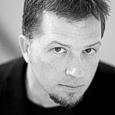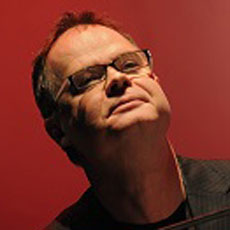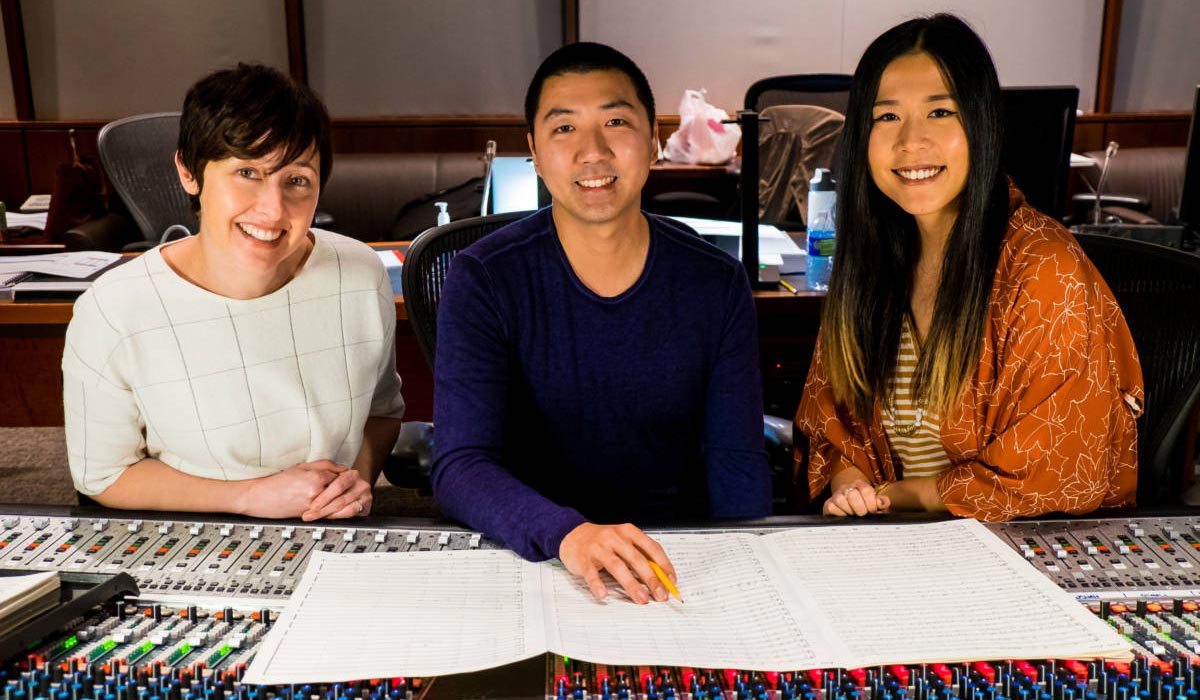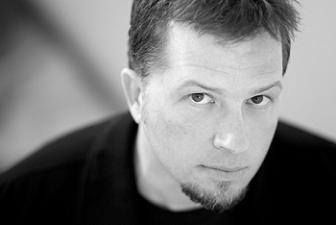 Composing for animated series is an art in itself. The themes have to give shape musically to a highly stylized universe within the crazy, fast-paced timeframe of an episode. From Alf Clausen (The Simpsons) to Adam Berry (Kim Possible), many composers excel in this domain, and to the list now has to be added Shawn Patterson.
Composing for animated series is an art in itself. The themes have to give shape musically to a highly stylized universe within the crazy, fast-paced timeframe of an episode. From Alf Clausen (The Simpsons) to Adam Berry (Kim Possible), many composers excel in this domain, and to the list now has to be added Shawn Patterson.
Born in the small town of Athol, Massachussetts, he has been composing music for film and television in Los Angeles since 1990. On of his first music composing jobs was for Terry Gilliam on The Fisher King movie trailer campaign. He started gaining attention in the animation world soon after his arrival on the original The Ren & Stimpy Show.
He has scored and produced music in a wide range of mediums: from film and television to film trailers, shorts and documentaries and has works for a variety of noted directors such as Henry Selick, Tom McGrath and many others.
Shawn is consistently in demand for his unique and powerful scores in episodic animated television, such as Oh Yeah Cartoons, The X’s, Dave the Barbarian and much more. Recently, he completed the musical score and songs for the smash animated hi series, El Tigre for Nickelodeon, which has earned him a 2008 Annie Award for Music in an Animated Television Production.
Today, Shawn adds another award nomination notch on his belt for original music scoring in animated television, being nominated at The Hollywood Music in Media Awards for Original Score in Television focusing on his song, Rings of Saturn that is featured in the upcoming stop motion animation comedy Titan Maximum that debuted on Adult Swim September 27th.
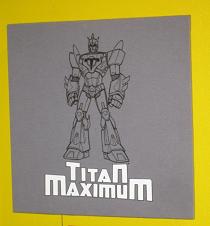
Animated Views: Despite the fact that you’ve worked for different mediums, you seem to have a particular taste for animation.
Shawn Patterson: It probably all goes back to my days starting in LA before I actually found work as a composer in town. I was lucky that I met a lot of really talented animators, storyboard artists and directors around. These people that I got to know, heard my music and were some of the first people to hire me. Over the years, as they have fanned out in the industry most of them have referred me to many other people. So, through many of these connections, I seem to keep getting hired in the animation scene.
 AV: What interests you in animation? It seems to be for you both a passion and a field of musical experimentation. Do you agree?
AV: What interests you in animation? It seems to be for you both a passion and a field of musical experimentation. Do you agree?
SP: Yeah, I definitely agree. One of the things that I have always loved about animation (and I would bet many fans of animation agree) is that there is an escape from reality that is instant. Characters can physically do things that humans can’t. Not that they have to, but they can. Here is an example; to me, one of the funniest scenes in the series El Tigre (of many funny scenes) was an extremely simple moment. The main character Manny is watching his mother fly through the air as a crazed super hero (even in costume), and he had no idea she had this dual existence. So, she is up in the air flying and stops and lets out this crazy, crazy scream. When the camera cuts back to Manny, he is completely silent and his eyes are freakishly tiny and very beady as he is just staring at his Mom. Completely out of model for the character – but it’s that one tiny moment where a human could not have done that. There was no music, no dialogue, perfectly timed. Just Manny looking very freaked out and it was all done with the eyes. That’s one of the great things about animation.
Then, take a series like, Titan Maximum – it’s stop motion and really, the characters do not do anything that humans could not do. But, the fact that they are stop motion and their world is very serious it is in itself, very comedic. I also love that aspect of this genre.
Regarding musical experimentation, composing for episodic animation is fast and furious. The sad part is that a lot of times there is simply no time in the schedule to get creative and try new things. Because, if you do stretch out and experiment musically, and the creative team does not like it, you have to go back to the drawing board and make up that time that you probably lost anyway because of a tight schedule.
I have had a several instances during Titan Maximum where I am very encouraged to stretch out and try new musical directions. So, once you do and it goes over well, it’s encouraging to do more. When I do stretch out musically, I find myself writing for odd groupings of instruments that I would generally not gravitate towards. There is a moment in Titan, where Willy (this little kid) is searching for something. I used two different time signatures, wrote in a two different tonalities and featured a bass trombone and a small jazz drum kit. But somehow, it all works. It’s really great to occasionally move away from traditional orchestration when scoring a scene like I just described; it’s refreshing.
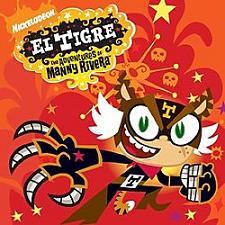
AV: Your expertise in animation music had been acknowledged by the awards for your work you have received. To you, what is “good” animation music?
SP: Well, I think any music of any style that is scored to picture simply needs to support the story, the characters, and the needs of the director. If the music achieves this, it has done its job. That of course, doesn’t mean the music by itself is good (!).
If you are talking traditional animation music, in my opinion Carl Stalling was the absolute best. He practically invented the genre of writing music to follow any character’s movement on screen. He was a true master of orchestration; always picking the best instrument to go with the movement of a character or whatever was happening at the moment. He could seamlessly weave popular songs or familiar melodies into an amazing score in a way that was staggering. Have you heard Scot Stafford’s score in Presto? That’s a wonderful example of following the Stalling approach to score but not just ripping it off; it’s outstanding.
You know, I don’t believe all music in animation should obviously follow Stalling’s style though. It would be a narrow world if it all did. I actually met some people that believe that’s the only way cartoons should be scored. I think that’s an extremely limited view.
Here is an example of an El Tigre episode – the only one from the series that was scored in a more “traditional” Carl Stalling style:
[flv:http://animatedviews.com/wp-content/uploads/2009/09/Tigre-119B-2.flv 320 240]
It’s one of the only times in my career where I was asked to score something as a sort homage to the man, Stalling.
AV: Can you tell me about the process and the schedule when scoring animated series?
SP: I like to get 5 – 10 days to score an 11 minute. That doesn’t always happen (!). You go in on a scheduled day, you spot the episode with whomever is in charge (director, producer, etc). Together, you watch the episode down and discuss the emotional needs of the scene; pacing, any specific hit points, where the music needs to get out, turn emotionally, etc.
Often there is a “temp” track cut in that the director may like. Depending on how attached to the temp track the director is, it can be a nightmare or it can really be a big help – especially when the director doesn’t speak in musical terms. I have worked with some that were so married to the temp track, that unless you almost re-create the temp track, there’s no way to win. And other people place more freedom in you and use the temp as a general guide which can really help identify the overall tone of the scene, the pacing, the colors of the instruments that are needed etc. Its great if you can find a project where that balance is in the middle; the temp track is important to follow but, is not there to simply be imitated.
It gets hairy in a schedule when multiple episodes start over lapping. If I have revisions and have to keep tweaking on one episode, starting a new one, bouncing out the stems from another to deliver to mix, it can get maddening. You must be extremely organized and sharp to knock it all out. Also, pacing yourself over the course of a series is critical. When I start working into every single weekend pulling 12 – 15 hours a day every day, I have to pull back a bit. Otherwise, life passes by completely. And I never want to pull back, because I want to create the best music possible for whatever project I am on. It’s very important to me.
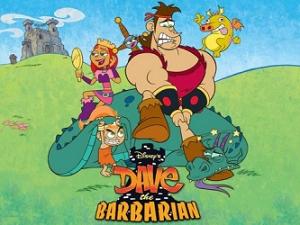
AV: You scored different types of animated productions, from traditionally animated like Disney’s Dave the Barbarian to stop motion with Titan Maximum. Does the type of animation influence the way you approach the product musically?
SP: Not really, because it all depends on the style the director wants to go in. I think a lot of animation is really becoming more cinematic in it’s sensibility. In what I have seen and been asked to score, generally I have not seen any differences in the way in which the story is told and how that affects music.
AV: At the beginning of a series, how do you create its musical aesthetics?
SP: Often a director will have a lot of insight to what they are musically looking for on their project. For El Tigre for example, Jorge generally wanted a broad Ennio Morricone score approach. There were also many moments where a contemporary approach to the music was needed; hip hop, R&B ballads, speed metal, etc. I suggested incorporating elements of flamenco and leaning on some of Elmer Bernstein and Aaron Copland’s musical style to add to the depth of the score as well.
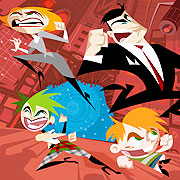 I also look at the show in terms of color, lines, overall pacing, etc. In the case of The X’s (for Nickelodeon) it was visually a loud show; hard lines with bold backgrounds so, I am sure I subconsciously wanted to tone down some of the instrumentation. I leaned on vibes put through a Leslie rotating cabinet to warm it up a little. The original sound that Carlos and I were experimenting with was very unique and a lot of fun. Tons of lo-fi drum machines, loops through filters, distortion boxes, etc. It’s probably best we didn’t go that route, as it would have been a bit of sensory overload (!). But, it was great fun to experiment with for sure.
I also look at the show in terms of color, lines, overall pacing, etc. In the case of The X’s (for Nickelodeon) it was visually a loud show; hard lines with bold backgrounds so, I am sure I subconsciously wanted to tone down some of the instrumentation. I leaned on vibes put through a Leslie rotating cabinet to warm it up a little. The original sound that Carlos and I were experimenting with was very unique and a lot of fun. Tons of lo-fi drum machines, loops through filters, distortion boxes, etc. It’s probably best we didn’t go that route, as it would have been a bit of sensory overload (!). But, it was great fun to experiment with for sure.
AV: You’ve scored a lot of comic animated productions. Can you tell me about the different techniques you use in order to stress or enhance humor.
SP: Well, there are so many instances where the visuals are so exaggerated and the score will often follow suit. You know, how many times has a character on screen started freaking out, screaming lets say, I am asked to score the biggest most bombastic diminished sting possible – truly a trademark of animation.
Other times, for comedic purposes contrast in the score is used. In Titan, we are using a good deal of contrast; for example, in episode nine in one scene Sasha grabs one of the villains (that actually look likes a very young girl with a cute backpack) and starts punching her repeatedly in the face. The score follows that moment as a sort of Herb Albert relaxed bossa nova while this uncomfortable violence is happening on screen. With the relaxed quality of the music, the moment of violence is diminished and made to feel like it’s “business as usual”. It’s pretty effective and further punches the joke instead of playing the scene with music that sounds “goofy” or even violent. The intentional disconnect of the music simply plays the joke harder.
Many times, the more real and serious the music takes itself, the harder the joke will play. For example, when a character is revealing an emotional or very real side of themselves, the more we see and feel the stupidity of their intimate feelings by having the music sound very real and sincere. If the music is played “funny” or even has a hint of silliness – the joke is blown (assuming the audience was supposed to laugh and not genuinely feel for them…) It simply pokes fun at the seriousness of the moment by genuinely tracking that sincerity. We’ve seen it a lot in comedic features. How about near the opening of Tropic Thunder when Ben Stiller’s character is getting gunned down in slow motion and the ethereal female voice is scored over the heartfelt strings? It is really mocking the over use of the seriousness in so many contemporary films and scores. That’s what makes it funny. Well…that and of course, the ridiculous amount of bullets going into him in slow motion and how long the sequence takes (!).
Also too, a lot of times the music just gets out of the way and the joke on screen takes care of itself without any musical support. In Titan, we do a good deal of musical swells and build-ups which lead right up to the punch line in silence; almost like a fake out. The music gets out the way and the joke is not what you expect the character to say or do. Also, a lot of times the music is simply just cut off. It can give the same effect as a build up to a climax and it can really help punctuate a moment of awkwardness.
AV: What are your memories of Monkeybone and of your collaboration with Henry Selick?
SP: That was great fun to do and talk about experimental! Very free using bizarre percussion, weird kids voices and other unusual stuff. I know Henry really loved the animated opening and the music that I did, but I think the studio heads thought it was too bizarre so it got replaced with Anne (Dudley)’s score. I’d love to work with Henry again; he’s brilliant.
 AV: Can you tell me about El Tigre and how you came to that idea of a very “Morricone”- like sound.
AV: Can you tell me about El Tigre and how you came to that idea of a very “Morricone”- like sound.
SP: The sound was all Jorge and Sandra’s idea. We are all huge fans of the Eastwood westerns. I also grew up on the John Wayne westerns that had Elmer Bernstein’s beautiful scores. Morricone’s sound is a brilliant and yet almost has become a cliché caricature of the imagery of a western. So, again, you get this musical score that we feel as somewhat familiar (the Morricone twang guitar, the stark high pitched strings, etc) and set it against a humorous set of characters and situations and we feel the humor more. It was a challenge and a joy to take elements of the Morricone sound and try to do something slightly new and fresh with it. Even in Titan Maximum, I recently had a request to do a sort of “space western” – elements of the western approach, but I incorporated some “Johnny Cash” style drums, large choir and odd synthesizers to incorporate the show’s Main Title.
AV: Now that you have dealt a lot with humorous series, is it also a personal desire of yours to get to a more emotional approach to scoring in general? Or do you think comic series is still a nice pendant/counterpart to your classical/concert work?
SP: I suppose there are times when I would love to get some of the scoring jobs that Alexandre Desplat gets; the more serious and intimate scores. And certainly working with longer form like feature length is nice. But, there is a fine line for me when doing “serious” film or television scores. In my world of writing music for various forms of animation, I am often – very often – asked to score very serious scenes and use the orchestra to help sell a moment of real emotional believability. I mean, obviously, a good deal of the time when I am asked to score something serious, contemplative, and/or reflective, etc, it’s ultimately for the purposes of setting up a joke.
So, from my perspective, I do get moments of scoring serious emotions. Of course, if the story is great, the character development is great – then I would absolutely love to score it. But I don’t necessarily seek those genres out. I also think many composers confuse the more serious genre of film/television score with “credibility”. In other words, if you are not scoring some high profile video game or live action film that is set in minor tonalities, all brooding and taking itself very seriously than you are simply not a “serious composer”.
Also, listen to the scores that are so common out there…these minor, tense, pulsing scores who’s primary purpose is to take themselves very seriously and so often, help sell a story line that is sometimes difficult to take. Is it just me or does that often get very old and predictable? Scoring comedy – with its many twists, turns and ability to laugh at itself – that has not become old to me yet.
Regarding my own musical works not composed for picture, I really don’t have much time at all to devote to it although I have many pieces of my own that I want to finish. If I had a grant or some kind of funding, I could take time off and focus on that exclusively – and believe me, I’d love to. I have two symphonies and many smaller jazz works for smaller ensemble that I’d love to finish. I feel I have spent so much of my career writing music specifically scored to picture that it would be a dream really to just work on my own musical works for the sole purpose of doing it. I also plan to get more into teaching at the university level at some point. I love the discussion and example of music to picture and it’s something I plan to get into further into down the road.
AV: Can you tell me about your approach to the Kung Fu Panda series? What was your attitude regarding the musical approach and the themes of the original movie?
AV: Well, I have only completed the pilot episode so far. But, the general idea was that the studio and our director, Gabe Swarr wanted to have it feel reminiscent of Hans and John’s great score, but to clearly have it’s own themes and feel. I personally think the characters are so strong in their personalities the score could have even more use of traditional Chinese instruments. But, I agree with Gabe that having a sense of nice familiarity of the film’s music, but not feeling like a bad knock off is the way to go for the overall episodic score. I paid close attention to Hans and John’s use of orchestration and what traditional instruments were used and then wrote my own motifs and themes.

AV: What was your attitude regarding the use of ethnic, traditional Chinese instruments?
SP: As many as possible! They can really easily blend with the western orchestra – except for occasional tuning problems. And of course, certain Chinese instruments lend themselves better to certain emotional moments. The erhu as expressive as it is can be a little tough over moments with heavy dialogue due to its general tonality and unless it’s used in its lower range. But over all the ehru is an incredibly expressive instrument with a haunting sound.
AV: Being a musician yourself, can you tell me about your experience with the musicians you work with?
SP: I rarely have time to work with musicians that are not on a project I am scoring for my own music. There are tons of amazing musicians who’s approach to music I love and only wish I had the time to collaborate with; I always try to it just rarely pans out. I like experimenting with music and musicians that try to walk out side their comfort zone and try new things.
AV: What kind of film or series would you like to work on after Titan Maximum?
SP: Well, I’d like to do more stuff that’s really experimental and outside of the norm. I am scoring a pilot for Nickelodeon coming up called, You’re a Bad Man, Mr. Gum which I am really looking forward to. Musically it will be very diverse having orchestration elements of Frank Zappa, The Beatles and combining this with score and just a bizarre blend of instruments. It should be a musical blast.
There are a few projects I am lining up right now that I can’t get into, but I will say one will pay homage to one of my greatest film score influences. That will be a treat for sure.
I just want to keep working on projects that challenge me musically and are satisfying to score.
With special thanks to Shawn Patterson and to Michelle Miller at Royal Flush, and to James!



